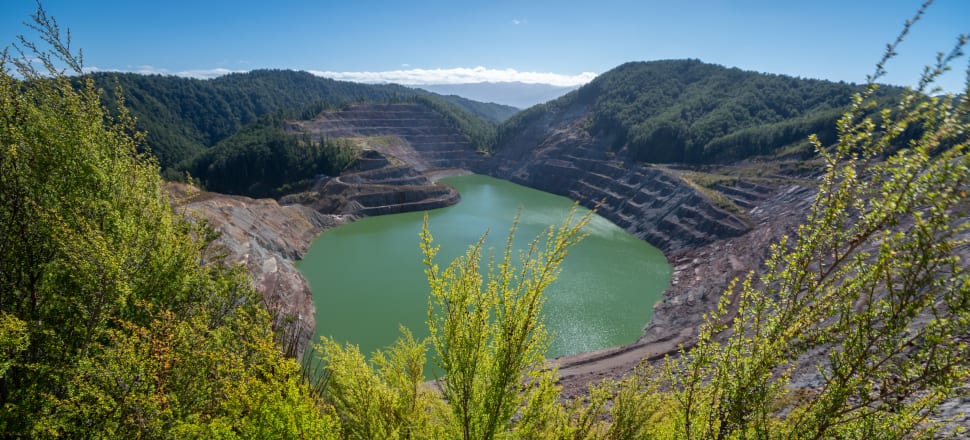
The threatened loss of road access to a former mine at the behest of the Conservation Department has Forest and Bird volunteers and heritage advocates up in arms
West Coast conservationists who protect birdlife around a former gold mine are worried plans to return the area to nature will – perversely – nullify eight years of hard slog to control pests.
Under its restoration agreement with the Department of Conservation, OceanaGold must demolish a bridge and access road it built to its Globe Progress Mine in Victoria Forest Park where extraction finished in 2016.
But Forest and Bird volunteers who trap stoats and rats in the steep catchment say destroying the road and bridge over the Inangahua River will make their work harder.
READ MORE: * West Coast councils baulk at fluoride cost * Coast Economy surges ahead of the rest
Local vet Brenda Kaye says she and others used to easily tramp up the mountain and back in a day to check the traps, but not these days.
“Most of us are now in our 70s. I’m 74 and I can still manage the downhill but we’ve been relying on the OceanaGold guys to drive us up there to the top so we can work our way down.”
The company has spent millions of dollars on rehabilitating the opencast site, planting close to a million trees and creating wetlands and lakes in the former pits.

DoC has praised the effort as a “world-class” restoration project.
But once OceanaGold goes, along with its road and bridge, the pest-control volunteers and the birds will be in trouble, Kaye says.
“DoC used to protect the area until it struck a deal with OceanaGold to pay for pest control in the Maruia Valley instead because it was a higher priority.”
But the steep Rainy Creek catchment patrolled by the volunteers has an important function that’s been overlooked, Kaye says.
“It’s the only wildlife corridor between the alps and the southern Paparoa Range and we think it’s vital to protect that.
“It doesn’t make sense to spend all this money recreating a forest if the birds and their eggs are just going to get eaten.”
Trap for old players
Spend a day with Kaye scrambling downhill on the lines of traps and the dedication of her small band of volunteers becomes apparent.
There are no formed tracks, just a series of blue ribbons on the occasional tree to mark the route.
Fallen tree trunks block the way in many places and negotiating the pitted ground means you admire the forest at your peril.
Beech trees soar skywards and plunge to the valley floor.
“How the hell do we get down there?” I inquire, suppressing panic while trying to sound interested.
“Quite carefully,” says Kaye, a mountaineer in her younger days who recently had an ankle joint replaced.
The final descent involves clambering into and out of a 3m-deep water race, slithering down the steeper slopes on your backside and lowering yourself down vertical banks on fixed ropes.
Or in my case, swinging like a pendulum, white-knuckled and cursing, as an encouraging Kaye points out footholds.
The rewards for the day’s labour are a smelly stoat and six big rats, flattened weeks ago by the kill traps.
And lunch perched on a log in the dappled green light serenaded by tūī, robins, tomtits, bellbirds and grey warblers while high above curious kākā screech.
There’s no sign, though, of the southern kōkako, whose reported sighting some years ago was one reason the volunteer trappers began their work.
“The kākāriki were coming back too but we lost them in a mast year [when the beech fruited] and the rat numbers got out of control,” Kaye says.
“We try to check the traps once a month but I haven’t been up here for a while because of the ankle.”
A couple of 1080 drops over the decade could have achieved the same results as years of work by the Forest and Bird volunteers, she says.
“But that’s expensive and a lot of locals are very opposed … it is what it is, and we’ll just keep going with the traps as long as we can get up here.”
Leaving the door open
The Forest and Bird members are not the only group keen to save the bridge and the road to the Globe site.
Mining engineer and historian John Taylor, who worked on the design of the OceanaGold mine in the 1990s, wants public access to be retained.
“It’s a heritage site. There are still artefacts up there from the original underground goldmine.
“There’s an amazing wetland now with lots of birds on the old tailings.”
Globe is also a first-class example of how modern mining sites can be restored, Taylor says.
“There’s more interest in this stuff than you might think.”

As a member of the West Coast Conservation Board and curator of the nearby Blacks Point museum, Taylor takes visitors including school parties on tours of the town’s historic School of Mines and other sites.
“A group of us Reefton people made submissions to DoC and OceanaGold last March when they asked us for ideas on the future of the Globe site.
“Since then we’ve had absolutely nothing. No response to our submissions and no sign of a DoC post-closure plan,” Taylor says.
DoC understandably wants to avoid liability for the road and the bridge, he says.
“There’s a health and safety issue up there … local teenagers could have a beery party, jump off the benches [high banks] around the lake and drown.”
Vandalism is also a potential problem, he says.
But with goodwill on all sides, some stout gates - and maybe a concession for a shuttle bus - the obstacles could be overcome.
Local firm Rosco, which has a gravel licence on the river’s far bank, is willing to take over the bridge maintenance at its cost, Taylor says, and look after the road as a paid service.
“It’s even put in a contract estimate to DoC.”
Money held by DoC as a bond for the demolition of the bridge and road could instead be used to maintain the road for years, he says.
DoC non-committal
DoC senior biodiversity manager Darrell Haworth says the department has yet to decide the fate of the road and bridge.
But he is clear that DoC has little interest in taking over the pest-control work.
“The likelihood of this being done by DoC staff is low.
“It is not one of our high-priority areas and financial constraints mean we are unlikely to be able to fund this in the future.”
Taylor and others plan to set up a trust that could oversee the Globe’s future and hope DoC will agree to deal with them.
“But time’s running out. OceanaGold is nearly finished up there and the last thing it has to do is rip out the road and bridge.
“We need a decision.”
Made with the support of the Public Interest Journalism Fund








